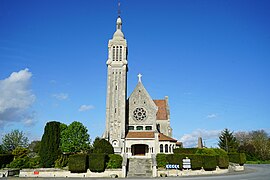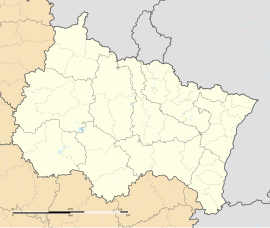This article needs additional citations for verification. (September 2016) |
Dontrien (French pronunciation: [dɔ̃tʁijɛ̃]) is a commune in the Marne department in north-eastern France.
Dontrien | |
|---|---|
 The church in Dontrien | |
| Coordinates: 49°14′24″N 4°24′47″E / 49.24°N 4.4131°E | |
| Country | France |
| Region | Grand Est |
| Department | Marne |
| Arrondissement | Reims |
| Canton | Mourmelon-Vesle et Monts de Champagne |
| Intercommunality | CU Grand Reims |
| Government | |
| • Mayor (2020–2026) | Philippe Chardonnet[1] |
Area 1 | 12.66 km2 (4.89 sq mi) |
| Population (2022)[2] | 259 |
| • Density | 20/km2 (53/sq mi) |
| Time zone | UTC+01:00 (CET) |
| • Summer (DST) | UTC+02:00 (CEST) |
| INSEE/Postal code | 51216 /51490 |
| Elevation | 107 m (351 ft) |
| 1 French Land Register data, which excludes lakes, ponds, glaciers > 1 km2 (0.386 sq mi or 247 acres) and river estuaries. | |
Geography
editDontrien is a small village in the north of the Marne department, about 35 km from Reims and 40 km from Châlons-en-Champagne.
On its territory, Dontrien has two rivers, Suippe and Py, which are full of fish. Since the 1970s, Baloré, a small beach on the Suippe has been successful.
History
editThere are different possible origins for the name, such as "don de rien" ("gift of nothing"), i.e. a gift given during the Middle Ages from a Lord to one of his vassals at a time when Dontrien was a forest with no land suitable for cultivation.
In 1247, there was an outbreak of leprosy.
In 1905, 955 hectares were used by farmers and 300 hectares for forest. The village comprised 325 people with 107 citizens in 109 houses. Of these 107 people there were 21 firemen, 1 station master, 3 wardens, 1 brewery, 1 bakery, 1 café, 12 farmers and 1 nurse.
Sport
editEvery 2 weeks, FC.Dontrien plays at the village stadium. In 2008, the team rose to the second division with 29 victories and 1 tie.
Personalities
editÉmile Zola briefly mentioned Dontrien in his novel La Débâcle, set around the time of the Franco-Prussian war:
- "Finally, around four o'clock, the 106th stopped at Dontrien, a village built on the banks of the Suippe. The little river ran among clusters of trees; the old church was in the middle of the cemetery, which a huge chestnut tree covered completely in its shadow. And it was on the left bank, in a sloping meadow, that the regiment had pitched its tents. The officers said that the four army corps were bivouacking along the course of the Suippe that evening, from Auberive to Heutrégiville, passing by Dontrien, Béthiniville and Pont-Faverger, a march of some five leagues [20 km]."[3]
See also
editReferences
edit- ^ "Répertoire national des élus: les maires" (in French). data.gouv.fr, Plateforme ouverte des données publiques françaises. 13 September 2022.
- ^ "Populations de référence 2022" (in French). The National Institute of Statistics and Economic Studies. 19 December 2024.
- ^ "Enfin, vers quatre heures, le 106e s'arrêta à Dontrien, un village bâti au bord de la Suippe. La petite rivière court parmi des bouquets d'arbres, la vieille église est au milieu du cimetière, qu'un marronnier immense couvre tout entier de son ombre. Et ce fut sur la rive gauche, dans un pré en pente, que le régiment dressa ses tentes. Les officiers disaient que les quatre corps d'armée, ce soir-là, allaient bivouaquer sur la ligne de la Suippe, d'Auberive à Heutrégiville, en passant par Dontrien, Béthiniville et Pont-Faverger, un front de bandière qui avait près de cinq lieues."


